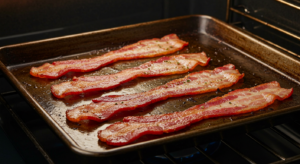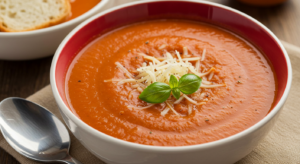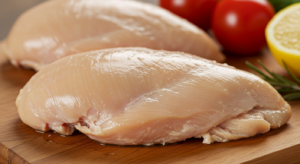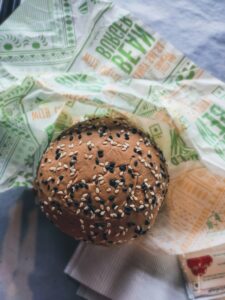
Smoke Brisket on Pellet Grill
When it comes to smoking brisket on a pellet grill, the temperature plays a vital role in the cooking process. The first step is getting the temperature up to around 225°F, low and slow is the key to a juicy and tender brisket. Once the brisket hits an internal temperature of 160-170°F, that’s the perfect moment to wrap it.
Wrapping brisket is a method often referred to as the Texas Crutch. This technique involves wrapping the brisket during the midpoint of the cooking process. Doing so helps soften the meat, ensures tenderness, and may speed up our cooking times somewhat.
Wrapping Brisket in Butcher Paper
You might wonder, “Why use butcher paper?”. Wrapping brisket in butcher paper is a popular technique because butcher paper, especially pink butcher paper, allows the meat to breathe, thus preserving the hard-earned bark from the smoking process. Unlike using aluminum foil, butcher paper will not create a steaming effect during the cooking process, which can make the bark mushy.
Aside from that, pink butcher paper is also a heavy-duty paper that could withstand heat and the meat’s juiciness. It is excellent for preserving the smoke flavor and crust, otherwise known as the bark.

Foil or Butcher Paper for Wrapping
The question of whether to use foil or butcher paper for wrapping brisket is a common one. While both methods have their proponents, the ultimate decision is yours based on your desired results.
Aluminum foil, on one hand, increases cooking speed because it creates a tightly sealed package that traps steam. But on the downside, this means the smoke flavor can no longer penetrate the meat, and it may soften the bark. Butcher paper, on the other hand, offers the best balance between maintaining a good bark and preventing the meat from drying out.

Optimum Temperatures for Brisket Cooking
Temperature control is paramount when you’re aiming for a perfectly cooked brisket. Once you smoke brisket and the internal temperature reaches 160-170 degrees Fahrenheit, then comes the wrapping stage.
After wrapping up your brisket, continue to cook until the internal temperatures reach 200-203 degrees Fahrenheit. This is the sweet spot where your brisket will be tender, moist, and full of flavor.

Unraveling the Cooked Brisket
Once you’ve reached the optimal internal temperature, it’s time to remove the cooked brisket from the grill. However, that doesn’t mean it’s ready to slice and serve. It needs to rest first.
Letting your brisket rest after cooking is just as integral a step as any other in the process. While the brisket rests, the juices redistribute throughout the meat, resulting in a juicier brisket. A proper rest period can take anywhere from 30 minutes to a couple of hours.

Should You Wrap Your Brisket?
Many pitmasters choose to wrap their brisket halfway through the cooking process. Wrapping helps to retain the meat’s moisture, speeds up the cooking process, and can even improve the meat’s taste and texture.
However, wrapping is not mandatory. Some BBQ enthusiasts prefer the “no wrap” method, believing that forgoing the wrap results in a better bark and a deeper smoke flavor.

The Pros of Wrapping With Heavy-Duty Aluminum Foil
Heavy-duty aluminum foil is highly resistant to tears and punctures — it’s ideal for wrapping and re-wrapping heavy cuts of meat like brisket. If you wrap in aluminum foil, the meat will cook faster because it will be in a steamy environment.
But one must remember that aluminum foil will soften the brisket’s bark, but in return, speeds up the cooking process and results in a tender and juicy brisket.

The Wizardry of the Brisket Fat Side
The brisket fat side can be a source of confusion for many BBQ enthusiasts. Should you smoke it fat side up or down? There’s no definitive answer to this question as it depends on your cooking method and personal preference.
If you smoke brisket fat side down, the layer of fat will help protect the meat from the heat. Conversely, if you smoke it with the fat side up, the fat can self-baste the meat during the cooking process.
What temperature should you wrap a brisket?
You should wrap your brisket when it hits an internal temperature between 160-170°F.
Is it better to wrap a brisket in foil or butcher paper?
Wrapping in butcher paper enhances the smoke flavor and bark quality, while foil speeds up the cooking process and makes the brisket tender.
Why do you wrap a brisket?
Wrapping a brisket helps retain moisture, speed up cooking times, and enhance the meat’s texture.
Is pink butcher paper necessary for brisket?
Pink butcher paper is not necessary but beneficial for preserving the smoke flavor and crust.
Is it okay to smoke a brisket without wrapping it?
Yes, it is okay. Not wrapping the brisket would result in a better bark and a deeper smoke flavor.
What happens if I don’t wrap my brisket?
Your brisket may be drier, and it will take longer to cook.
What is the Texas Crutch?
The Texas Crutch is a technique involving wrapping the brisket during the midpoint of cooking to improve tenderness and cooking speed.
At what internal temperature is brisket done?
A brisket is done when the internal temperature reaches 200-203°F.
Does brisket fat side impart flavor?
The fat does not permeate the brisket but can self-baste the meat during the cooking process.
What material is the heavy-duty aluminum foil?
The heavy-duty aluminum foil is a highly durable and resistant material ideal for wrapping heavy cuts of meat like brisket.








